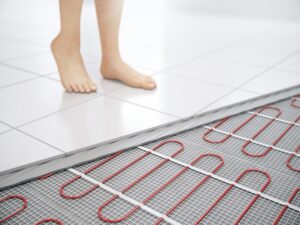When you’re building a new home, or remodeling your home, there are so many different things to consider. It can start to be completely overwhelming! You might be tempted to make quick decisions about certain aspects, going with whatever option is familiar just to simplify your process. But when it comes to your heating system, you don’t want to rush your decision.
The way to have a heating system that you’ll be happy with for many years to come is to carefully evaluate your options. Different approaches to heating will work better for different homes, families, and budgets. Radiant heating systems are a fantastic choice for many people. Take time to consider the pros and cons of this option. It might be right for you!
What Is Radiant Heating?
When most people talk about radiant heating, they mean a system that is laid under flooring, often called radiant floor heating or just floor heating. It can use electric heating cables, sort of like an electric blanket or heating pad, but more often it uses a hydronic or liquid system. Hot water runs through pipes under the floor to provide warmth.
Hot water systems that use radiators or registers are another common form of radiant heating that you might be more familiar with. Hydronic radiant floor heat uses the same principles with a different approach to where the pipes full of hot water are installed.
The Pros of Radiant Heating
- Evenness: Other common forms of heating such as furnaces (whether gas or electric) rely on air to distribute the warmth throughout the home. This can be ineffective or unpredictable, leaving some rooms extra warm while others have cold spots. Radiant systems, whether in-floor or through registers, provide heat that is more consistent and even.
- Air Quality: The forced air of other heating systems stirs up dust and contaminants in your home. Systems of ductwork provide places for moisture to pool and mold to grow, or for pollen to accumulate, and when the heat comes on, the airflow distributes these allergens through your home. Radiant heating is often preferred by people with allergies or respiratory concerns.
- Maintenance and Repair: The boiler which provides hot water to the radiant system only has one major mechanical component, the circulator pump. Furnaces have many more parts that can break down. Boilers require less maintenance, repairs are rare, and the boiler can have a life expectancy almost twice that of a gas furnace—30 years compared to 15!
The Cons of Radiant Heating
- Installation: Whether you’re considering floor heating or baseboard registers, the installation of these systems is more complex, time-consuming, and expensive than the installation of a furnace.
- Heating Speed: If your home’s temperature has dropped significantly, it takes a radiant system longer to bring the whole home to a comfortable temperature than it would take for a forced-air system to do the same job.
- Space: If you do choose radiators or baseboard registers, they will be visible and take up some space in every room of your house.
If you have questions about how radiant heating could be integrated into your home, a member of our team would be happy to talk with you about radiant heat service in Coeur d’Alene, ID.
ACI Northwest is here to help. Contact us today to discuss home heating options.

